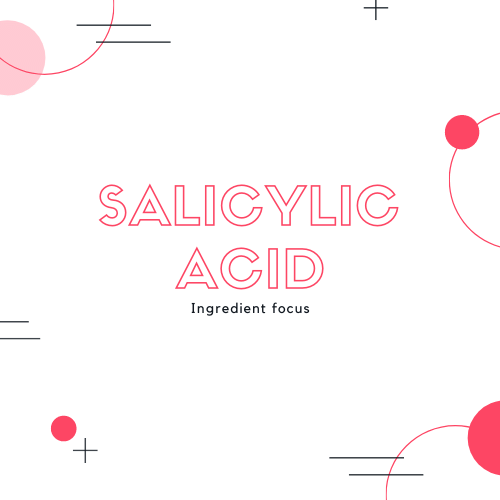(All references supporting the acid series are available at this LINK)
Introductions and trends in use
Salicylic acid is a naturally occurring BHA found in Wintergreen leaves, willow and sweet birch bark. Salicylic acid and its derivatives, have been available by a synthetic process since the mid-800s.
It is widely used as the precursor to the production of Aspirin as well. Finally, it is used as a preservative, in hair products and in cosmetics.
Within cosmetic formulations, its fairly standard to find SA in concentrations of 2% – 4%
Structure
It is a Beta Hydroxy Acid as well as an aromatic Carboxylic Acid.
Unlike Glycolic Acid and Lactic Acid, it is poorly soluble in water. It is lipophilic, so its soluble in fat/lipids.
Studies show that despite its heavier structure (vs. Glycolic Acid) its readily absorbed when applied on skin. While absorption depends on the vehicle of delivery, pH, structure of the skin etc, the absorption from topically applied 2% Salicylic Acid containing products is c.20% of the applied dose.
Benefits
When Salicylic Acid is used on the skin, it promotes desquamation of epidermal cells (because I think) it destroys the intercellular lipids that are covalently linked to the cornified envelope surrounding conerneocytes in the stratum corneum). This results in desquamation..
Its lipophilic properties mean it can penetrate comedones and pores to prevent clogging.
SA also has antibacterial activity, which involves downregulating the production of compounds that are necessary for the replication of bacteria in tissues
Salicylic Acid is also anti-inflammatory.
Finally, Salicylic Acid used does not create the same photo-sensitivity in skin that Glycolic Acid does (This was demonstrated in a small 14 person study, using Type II and Type III type individuals: 10% Glycolic Acid was found to increase sensitivity of skin, but 2% Salicylic Acid did not)
Side-effects
Salicylic Acid has the same side effects that you would expect of a hydroxy acid – there is no let up there.
An Asian study[1] involving 286 people were treated with a superficial Salicylic Acid peel for 8 weekly sessions for various facial conditions (melasma, acne, PIH and son on). While most patients tolerated the peel well, those that did not complained of the following side-effects (which were easily managed):
- Mild discomfort
- Burning
- Irritation
- Erythema
- Excessive dryness
However, Salicylic Acid does have fewer side effects in Glycolic Acid (when compared to Glycolic Acid. Similarly, it would appear that Salicylic Acid is better than either Lactic Acid or Glycolic Acid in treating acne.
Mandelic Acid on the other hand, has fewer side effects than Salicylic Acid in the treatment of acne. Also, note that Salicylic Acid is quicker acting than Madelic Acid.
The following should think of using this acid….
Anyone with acne, but you already know that!
Studies I have looked at indicate comedonal and inflammatory acne is what Salicylic Acid is best at targeting.
If you have oily/excessively oily skin, then Salicylic Acid will remove the extra sebum and you could think of using a low concentration of it.
The following should not be using Salicylic Acid
Dry, Normal and combination.
Anyone who does not have acne prone skin
But be sensible, if the product label indicates that Salicylic Acid or Willow Bark extract is (eg) the 10th ingredient, then its likely that the product is using anti-inflammatory properties.
Products for first time users?
Acne is a very serious and debilitating condition.
I am not comfortable suggesting products, just because as a teenager I had acne or as an adult, I have had bouts of acne. I don’t live with acne.
